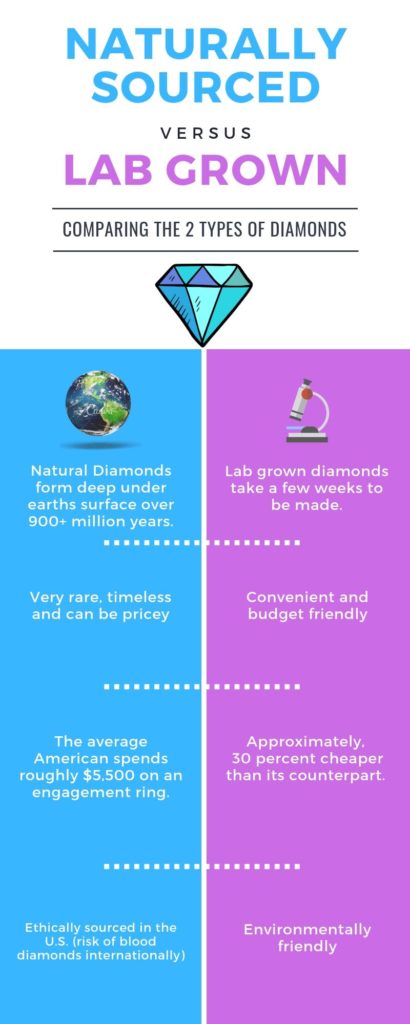Get This Report about Lab Grown Diamonds
Wiki Article
Our Lab Grown Diamonds Diaries
Table of ContentsNot known Details About Lab Grown Diamonds Fascination About Lab Grown DiamondsLab Grown Diamonds for BeginnersAbout Lab Grown Diamonds
As you take a trip closer to the Planet's core, pressure and temperature increase, which creates the ideal oven for carbon to be exchanged ruby (rubies are the only gems to be made from purely one element). Through a substantial volcanic eruption, these rubies were transported to the Planet's surface. It's estimated this process was rather fast (more than likely over the training course of a number of hours), which allowed the diamonds to remain undamaged without melting.The short solution: carats gauge the mass of stones, karats determine the pureness of gold. Carat: 1 carat is equivalent to 0.2 grams, concerning the weight of a paperclip (next time you see a picture of Mariah Carey's 35 carat weight involvement ring, simply visualize the burden of lugging 35 paper clips around your finger daily).

Below are a few of the vital benefits of laboratory grown diamonds and laboratory grown up diamond jewellery:.
Lab Grown Diamonds Fundamentals Explained
In other words, natural or earth-mined rubies are crafted over millions of years below the Earth's crust from pure carbon combined with stress and warmth. Producing diamonds in a lab requires the same process, simply fine-tuned to take place over a much smaller timespan in a a lot more regulated setting.Whereas earth-mined diamonds are rare and limited and often tend to raise in rate over time, laboratory diamonds are readily offered., like lab-grown ruby rings, they won't be a great fit for your requirements.
They may think that the disadvantages of lab-grown diamonds surpass the pros. Some may argue that, for this factor, buying a lab-made ruby additionally comes with its ethical considerations, as doing so takes earnings away from those entailed in the natural diamond industry who might require it most.
Conventional diamonds count on the Planet's conditions to determine their top quality or absence thereof. Yet in a lab, producers can directly manage a ruby's high quality. Yes, there are moral and environmental factors to consider with both extracted and synthetic rubies. Expect your spending plan just allows you to buy particular shades or cuts of natural diamonds.
The Facts About Lab Grown Diamonds Revealed
You can quickly locate colored, synthetic rubies on the (relatively) inexpensive side as well as certain cuts that would certainly be costlier if you were shopping for an extracted ruby just. That hardly means it isn't worth protecting.natural rubies is that the latter is extracted from natural deposits in the Earth while the previous is made in a lab using controlled settings. Their high quality is greatly the same. While the difference between lab-grown and all-natural ruby choices are marginal when it pertains to high quality, several of the downsides of lab-grown rubies include the fact that the stone will certainly diminish in time and, to some, an absence of emotional value that's frequently related to extracted diamonds
The process involves very little land interruption and gets rid of issues connected to deforestation and environment devastation. Lab-grown rubies are commonly extra budget-friendly than all-natural diamonds. This cost distinction can be connected to the streamlined production procedure and the evasion of expenses related to traditional mining. The Controlled Setting in Which Lab Grown Diamonds Are Developed Allows for Regular Quality.
Adaptability in Layout - Laboratory Grown Diamonds Offer Designers and Customers a Versatile Combination to Develop One-of-a-kind and Innovative Jewelry Designs - Lab Grown Diamonds. Lab Diamonds Frequently Come with An Even More Transparent Supply Chain.
Not known Factual Statements About Lab Grown Diamonds
Market Understanding - In Spite Of Their Identical Physical Characteristics, Lab Diamonds May Face Tests in Market Understanding. Some Customers Still Perceive Natural Diamonds as Having Higher Worth and Stature. The Production of Lab-Grown Diamonds Can Be Energy-Intensive, Particularly in Methods Like High Stress High Temperature level (hpht) and Chemical Vapor Deposition (cvd).Natural Diamonds Are Created Over Numerous Years Deep Within the Planet, Adding to Their Perceived Rarity. Lab-Grown Diamonds, Despite Their Similar Quality, Might Not Lug the Same Rarity Element, Affecting Their Viewed Value for Some Consumers. Influence on Diamond-Dependent Economies - the here Shift Towards Lab Grown Diamonds Might Have Economic Effects for Nations and Communities that Rely On The Ruby Mining Market.

Ans. Laboratory Diamonds Are of Equal High Quality to Natural Diamonds in Regards To Firmness, Brilliance, and Clarity. the Quality of A Ruby, Whether Lab-Grown or Mined, Is Identified by Its Cut, Shade, Quality, and Carat Weight. Ans. Yes, Lab Diamonds Shimmer Simply Like All-natural Diamonds. Their Luster and Sparkle Are a Result of Their Cut and The Method Light Engages with Their Aspects. Ans.
Report this wiki page